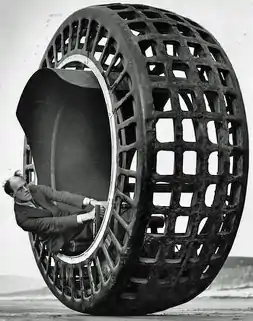Dynasphere
The Dynasphere (sometimes misspelled Dynosphere[2]) was a monowheel vehicle design patented in 1930 by Dr J. A. Purves FRSE[note 1] (7 August 1870 – 4 November 1952[3]) from Taunton, Somerset, UK.[4][5] Purves' idea for the vehicle was inspired by a sketch made by Leonardo da Vinci.[6]

Detail
Two prototypes were initially built: a smaller electrical model, and one with a gasoline motor[1] that attained either 2.5[7] or 6[8] horse power depending on the source consulted, using a two-cylinder air-cooled Douglas engine with a three speed gear box, also providing reverse.[8] The Dynasphere model reached top speeds of 25–30 miles per hour (40–48 km/h).[1][8] The gasoline-powered prototype was 10-foot (3.0 m) high and built of iron latticework that weighed 1,000 pounds (450 kg).[1] The next generation version had ten outer hoops, covered with a leather lining, shaped to present a small profile to the ground.[8]
The driver's seat and the motor were part of one unit, mounted with wheels upon the interior rails of the outer hoop.[1] The singular driving seat and motor unit, when powered forward, would thus try to "climb" up the spherical rails, which would cause the lattice cage to roll forward.[8] Steering of the prototype was crude, requiring the driver to lean in the direction sought to travel, though Purves envisioned future models equipped with gears that would shift the inner housing without leaning, thus tipping the Dynasphere in the direction of travel.[1] The later ten-hoop model had a steering wheel engaging such tipping gears, and was captured in a 1932 Pathé newsreel, in which the vehicle's advantages are first described and then demonstrated at the Brooklands motor racing circuit.[9] A novelty model was later constructed by Purves that could seat eight passengers, the "Dynasphere 8", made specifically for beach use.[10]
Purves was optimistic about his invention's prospects. As reported in a 1932 Popular Science magazine article, after a filmed test drive in 1932 on a beach in Weston-super-Mare, Somerset, he stated that the Dynasphere "reduced locomotion to the simplest possible form, with consequent economy of power",[1] and that it was "the high-speed vehicle of the future".[1] An article in the February 1935 issue of Meccano Magazine noted that though the Dynasphere was only at an experimental stage, "it possesses so many advantages that we may eventually see gigantic wheels similar to that shown on our cover running along our highways in as large numbers as motor cars do to-day."[8] According to the 2007 book Crazy Cars, one reason the Dynasphere did not succeed was that "while the [vehicle] could move along just fine, it was almost impossible to steer or brake."[6] Another aspect of the vehicle that received criticism was the phenomenon of "gerbiling"—the tendency when accelerating or braking the vehicle for the independent housing holding the driver within the monowheel to spin within the moving structure.[11]
See also
Notes
References
- "Amazing Motor-Driven Hoop May be Car of the Future". Popular Science. Bonnier Corporation. 120 (5): 63. May 1932. ISSN 0161-7370.
- "Rolling but not Rio". Tyrone Daily Herald. Tyrone, PA. 8 March 1932. p. 6.
- "Former Royal Society of Edinburgh Fellows 1783 - 2002" (PDF). The Royal Society Of Edinburgh. p. 756. Retrieved 21 March 2012.
- "In pictures: Dynasphere testing on Weston beach in 1932". BBC News. 23 December 2009. Retrieved 5 September 2010.
- U.S. Patent 2,009,904, filed 16 September 1931; issued 30 July 1935. Retrieved on 21 March 2012.
- Doeden, Matt (2007). Crazy Cars. Minneapolis, MN: Lerner Publications. p. 35. ISBN 978-0-8225-6565-9.
- "How many wheels does a car need?: Purves Dynasphere" (PDF). Haynes Publishing. Retrieved 9 May 2010.
- "Rolling Along—Modern Style". Meccano Magazine. Meccano Ltd. XX (2). February 1935. Archived from the original on 2008-05-03.
- 1932 newsreel: Dynasphere described and demonstrated at the Brooklands motor racing circuit (1932) from British Pathé (Record No:2766) at YouTube
- "Riding Inside the Tire of the New One-Wheel Motor Car". The Troy Call. Troy, IL. 18 August 1933. p. 3.
- Svoboda, Elizabeth (January 2004). "Careful: Too Fast and You'll Start Gerbiling". Popular Science. Bonnier Corporation. 264 (1): 112. ISSN 0161-7370.